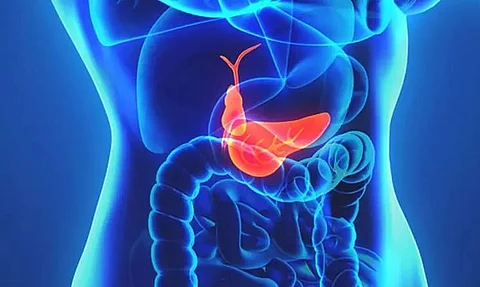
- Home
- Live Blog
- Breaking News
- Top Headlines
- Cities
- NE News
- Sentinel Media
- Sports
- Education
- Jobs

The gall bladder is a small organ tucked up under the liver on the right side of the body, specifically in the upper side of the abdomen. It is shaped like a swollen pea pod. It's job is to store and dispense bile – a fluid that helps digest fats in the food .The gall bladder is connected to other parts of the digestive system through a series of ducts or tunnels.
Gall bladder (GB) stone is one of the most common causes of abdominal pain. In India, every year, gall stones are diagnosed in about 10 million people through tests. There might be many more cases that go undetected. More than 50 % cases occur in women particularly in young women who are in their twenties, thirties and forties.
What is the cause of GB stone?
It is indeed very surprising how stones are formed in the body fluid (bile) from the cholesterol, which it contains. We commonly find a family history of gall stones in most patients though any genetic coding for that is hitherto unknown. Gall bladder stones are somehow commoner in affluent sections of people. Therefore some researchers presume it to be a lifestyle disease too. They attribute it to higher fatty food intake and sedentary living. Even sudden weight loss is associated with GB stone so fad dieting should be avoided.
What are the common symptoms?
About 40 to 50% patients have no definite symptoms. They are diagnosed through a USG (ultrasonogram) while undergoing routine health checkups or investigations for other health complaints. However, pain in the abdomen especially on the upper right or middle- sometimes radiating to the right shoulder -are the common complaints of most gall stone patients. At times this pain is accompanied by nausea and vomiting specifically after having meals or fatty food. Severe pain with fever may indicate complicated gall stone disease.
What is complicated GB stone ?
When stones get impacted at the neck of the gallbladder it may lead to severe infection, accumulation of pus ( Empyema) or even perforation due to over distension gangrene. Particularly in diabetic patients this may be a severe complication.
GB stones which are relatively smaller in size may easily slip out from the gall bladder to the bile duct to occlude the liver and pancreas giving rise to jaundice, sepsis, biliary pancreatitis etc which may need emergency intervention.
Does stone size matter in terms of deciding the optimum treatment options?
Well absolutely NO. I have already mentioned the problems with smaller stones. There is a higher chance of cancer of the gall bladder with big stones especially if they are lying for long periods of time. This can be a precancerous condition as per some text books. As soon as stones are detected, one must consult a surgeon and appropriate management must be done.
Is there any medical treatment for GB stone?
Any method of treatment other than surgical removal of GB is futile and may invite complications in any otherwise uncomplicated disease with time. In this era of minimal access surgery, laparoscopy is the gold standard method of management.
How safe is GB removal surgery ?
Invariably gall bladder is removed through laparoscopic surgery and this procedure is absolutely safe in expert hands particularly in today's times that are replete with cutting- edge technologically advanced equipment. The patient is admitted early on the day of the surgery and usually the surgery is a short duration procedure. Patients can move hours after the surgery due to the use of ultra short acting anesthetic medication and discharged the next day.
What are the advantages of the laparoscopic method ?
There are several advantages. Firstly the cuts that are made are very small resulting in very less discomfort. The patient goes back home with a simple band aid. Secondly as there are small tiny incisions in laparoscopy, the chances of infection are extremely rare especially in well equipped hospitals. Thirdly the surgical incision marks disappears in course of time. That's why it's called the 'kindest cut by a surgeon' .
Are there any dietary or other restrictions after the surgery?
There are no dietary or physical restrictions after surgery. One may go back to normal daily activities very soon.
Can stones come back again?
As the gall bladder is completely removed there is no chance of recurrent stone in GB.
Why in kidney stone disease, only the stone is removed but in case of GB stone the entire gall bladder is taken out?
Kidney is a vital organ for the normal functioning of the body so it has to be preserved.
On the other hand gall bladder is not a vital organ so it can be removed safely and one can have a normal quality of life without GB.
Also Watch: